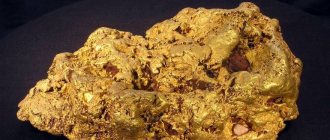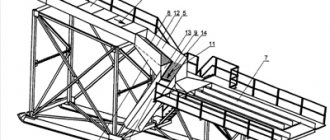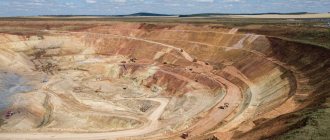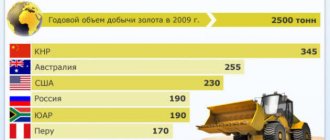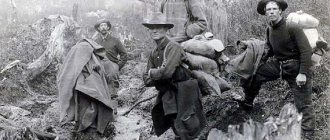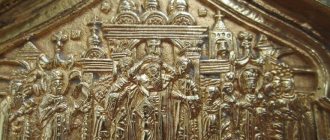The gold mining development of Distant Siberia, as the territories developed by Russian pioneers in the Lena River region were called, began in the mid-18th century. This name is reflected in the song about the wild steppes of Transbaikalia, which were crossed by a tramp who then swam across Baikal and learned about his brother, exiled to distant Siberia “to rattle with shackles.”
Don't deprive yourself of prey
One of these pioneers was mining engineer Nikolai Anosov, who carried out surveys in 1858 along one of the right tributaries of the Verkhnyaya Zeya. Near Mount Chichegur he came across an unnamed key, which he called the “Golden Treasure”. There Anosov discovered the richest deposits of gold, rumors about which regularly penetrated into European Russia. From then until 1920, according to conservative estimates, about a thousand tons of gold were mined in Far Siberia. Of course, mining was carried out both by legal methods (buying out territories, paying taxes, hiring miners), and by groups of insurgents who took gold using barbaric methods. This led to the flourishing of banditry and, as a consequence, to the creation of short-term “golden” republics, which collapsed with the development of veins and placers. There was a real war for gold: having learned about such a republic of “free miners,” the legal owners of the land carried out mass executions or set gangs of bandits against illegal mines. To this day, illegal miners in the taiga are called “predators.” They are called this because they are engaged in theft of gold from the depths, without buying the land for rent, without paying any taxes to the treasury. And also because the pit mining method they used, in which abandoned gold remains in the pillars between the pits, made the placers unsuitable for further development. Nevertheless, the “predators” always kept their noses to the wind and were the first to reach the gold veins. They are famous for being the discoverers of the Zolotaya Gora deposits, the gold placers of the Savushkin and Millionny streams, the upper reaches of the Ulunga, the Gilyuy River, and the Oktyabrsky mine. Unya-Bomsky and Sugdzhar-Toksky mine areas, the no less famous and mysterious Pyrite Cliff.
Points on the map
The most productive territory at the moment is considered to be the Irkutsk region. It is there that up to 90% of all precious metals are mined. During the entire period of development and extraction of the substance, about 1.5 tons of gold were mined. The deposits are mainly alluvial. And since 2000, production annually amounts to almost 10 tons of gold. And this is subject to the extraction of the substance only from placers, and the development of mines is also planned.
The main deposits of the Irkutsk region:
- Sukhoi Log is one of the most powerful deposits in the world, exploration of which began in the sixties of the nineteenth century.
- "Zapadnoe", which is located near "Sukhoi Log".
- "Devil's Trough", which is predicted to store up to 200 tons of metal.
- Verninskoye is a deposit that has great prospects.
Now he is mining gold. It is this company that is engaged in placer mining in Siberia, in particular, it is developing deposits in the Krasnoyarsk Territory and the Irkutsk Region.
Siberian gold is an important industry in Russia. The potential and reserves of the territories are very high, since all deposits have not been discovered and production is not carried out at full capacity. The lands of Kuzbass and Altai are being developed. In addition to gold, other minerals are being discovered that will bring great income to the state in the future. The lands of Siberia boast not only gold, but also coal, as well as rare base metals.
"Predators"
Among these “miners”, adventurers, various criminal elements, tramps and hunters for easy money predominated, who, alone or in small teams, with the help of a pick, a shovel, a washing tray, and less often a wheelbarrow, were engaged in illegal gold mining. Extraction was often accompanied by robbery in remote, underdeveloped mining areas, and then by selling it at one’s own discretion, often through smuggling, abroad and on the black market. The greatest demand among wild prospectors was for large gold and nuggets, the discovery of which was considered lucky. The workers who were busy washing the sands always looked out for large gold. All hoarding and saving of money among prospectors was despised. Working most of the year in the taiga, they had neither home nor family. Coming out to the city after seasonal work, predators squandered in a few weeks everything they had earned through hard work during the season. Having woken up the next morning after a spree in a tavern, they usually discovered the loss of money and bags of gold dust. There were no rich people among them, although they sometimes earned a lot of money during the season. Only those who were close to the miners got rich - gold buyers, suppliers of various supplies and alcohol, owners of mines. Unfortunately, the gold miners did not single out their own Jack London, a writer who would convey to his contemporaries the life of Russian miners, their successes and tragedies.
Bloody calculations
It’s an amazing thing - gold nuggets before the revolution, and even during Soviet times, were often equated to “unearned income.” Nemirovich-Danchenko spoke about this at the end of the 19th century: “Prospectors hand over the gold they washed to the central mines, receiving from the treasury from seventy-five kopecks to one and a half rubles per spool. If you came across nuggets, then the government paid for them only 15 kopecks per spool.” It turns out that it was more profitable to hide gold nuggets and then sell them to resellers abroad - this was facilitated by government policy (And to this day, payment for gold mining is much cheaper than the mined precious metal itself). At legal mines, the daily wage for the owner's workers when extracting sand reached 2.75 rubles. For a spool of native gold mined during artisanal work, companies paid up to 2.8 rubles. Zolotniki (workers who worked not for wages, but on piecework) were even more tempted to hide gold. Moreover, all the gold mined passed through the hands of the receiver. By handing over gold, he received 3-3.5 rubles per spool from the enterprise. With this form of remuneration and the state price for pure gold, at the exchange rate of 5.5 rubles per spool, gold mining companies received fabulous profits. Amur gold miners attacked every new deposit with ravenous greed, without stopping to commit crimes. They provoked bloody conflicts. Thus, a large party of prospectors who discovered rich placers on the Bom River was shot. Bloody violence also befell the “predators” on the Vilyue River, where the Millionny mine was independently developed. Many people were killed and robbed by hired bandits on remote taiga trails. The most famous Lena uprising of miners, with the subsequent execution of several hundred people, was provoked by gold miners by throwing a horse's penis into a cauldron of stew, which overflowed the patience of the working people.
History of metal mining
The history of the popularity of gold from Siberia began in the first half of the 19th century. It was then that the emperor issued a decree according to which Russian citizens were allowed to mine the precious metal, subject to the payment of taxes to the budget. The first deposit was the bed of the Sukhoi Berikul River, and local wine merchants took up its development.
Such actions on the part of the emperor brought good results. The regions began to develop, the population increased, trade processes intensified, and transport links improved. The Yenisei province, as well as the tributaries of the Kiya River, the Salair Ridge, and the mouth of the Mokry Berikul River became famous among gold miners and acquired a good infrastructure for those times.
Gold mining in Siberia became known outside Russia, and they began to search for the precious metal in other regions using the same principle. And the “Siberian gold rush” was replaced by the “California rush”. People from Europe went en masse to California in search of metal and to get rich. Gold was found there based on the similarity of the geomorphological structure of the soil.
But by the beginning of the 20th century, the industry was in decline, as money was no longer invested in it, and entrepreneurs switched to trade and shipping. After the revolution, precious metals were controlled by the Soviet government, which banned gold mining for citizens of the republic.
Short liberty
In distant Siberia, on a gigantic territory where at different times the mining of native, placer and ore gold was carried out among clouds of vipers, republics arose in skirmishes, the free population of which disappeared both with the production of gold and as a result of armed attacks. Predatory metal mining became particularly widespread during periods of “gold” rushes, of which there were a dozen. The first free republic arose in 1886, when Chinese troops destroyed the Zheltuginsky mines on the right side of the Amur, on Chinese territory. Up to eight thousand people went beyond the Amur to Siberia, where predatory fishing became widespread. The defeat of the “Zheltuginskaya Republic” provoked the creation of another republic of miners and predators - “Bomskaya”. It was to the Bom River that the bulk of the people from the Zheltuga River moved to the open gold placers. In some years, up to five thousand people mined gold here. At the end of the 19th century, a large “Society of Free Prospectors” was discovered on Savushkino Spring in the Gilyuy River basin. After mining the key, the “predators” moved to the neighboring key, Millionny, where up to three thousand people accumulated. During the Civil War and the post-war system, the center of freedom became the “Giliu Republic” with its capital in the form of the “Cuckoo” mine. The area of the Gilyuy River has long been chosen by insurgents, who for a long time did not part with the fertile taiga tracts. The ease of mining and the richness of placers kept the “predators” in these places for about seven years, despite the fact that they can only work here during a short summer period - after the flood subsides and until the first frost. Throughout Gilyuy, as well as in the adjacent valleys, as a result of large-scale illegal gold mining, many pits remained in the valleys, along the ridges of rivers and springs. In the end, this republic was finished as well. All the “predators” were completely exterminated, and the mining camp was burned. Similar consequences occurred for the republic on the Chukan River, which was liquidated, as they would say today, by “black raiders.”
Magazine: Secrets of the 20th Century No. 23, June 2010 Category: Searches and Finds Author: Alexander Agalakov
Tags: republic, Russia, Secrets of the 20th century, China, river, gold, Siberia, mine, mining, Amur, banditry, Zheltuga, Lena
- Back
- Forward

Bodaibo is a land of gold and bones.
We say “Bodaybo”, we mean “gold”. In Bodaibo, you can talk with the local population on any topic - it will still very soon come up with the topic of Bodaibo gold. Here, each of the numerous artels is a city-forming enterprise. Because besides gold mining there is simply nothing to do in Bodaibo, excluding, of course, the “female” craft of the social sphere - shops, schools, district administration...
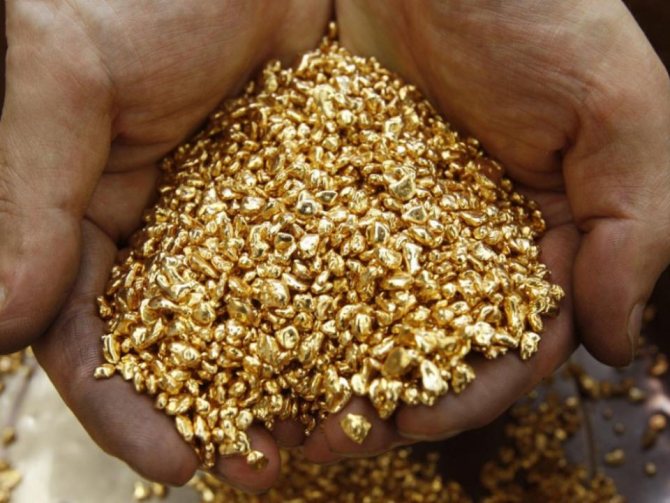
And the paradox is that far from being the largest district of the Irkutsk region, which annually replenishes the gold fund of the Russian Federation by 15-16 tons (just imagine this visually!) not only does not prosper and does not prosper - the district barely makes ends meet with ends. The Bodaibinsky district today, like a hundred years ago, is a hungry, exhausted prospector with an old handicraft tray, who walks around in rags for gold and mines precious sand “for his uncle”...
History of the Irkutsk Klondike.
Bodaibo from the height of an airplane flight resembles... Erbogachen. Both are regional centers. Erbogachen stretches out on the right bank of the Tunguska, Bodaibo along the Vitim. When the plane lands in Erbogachen, it feels like it is landing on potato beds. When the plane lands in Bodaibo, it lands right above the city, so it feels like it’s landing right on the roofs of buildings. But as soon as the plane stops, the main similarities and differences become visible. Erbogachen stands on sand - the entire village is on ordinary river sand. Bodaibo stands on golden sand. Residents joke: “We are walking on gold.”
The main paradox is that most Bodaibo residents have never seen gold. There is no jewelry made from local gold here, and the only jewelry store has imported gold. Although some say that if the state allowed the free circulation of gold, more than tens of kilograms of the precious metal would appear from the bins of some old residents of Bodaibo.
However, prosperity is obvious - with the ease of tricycles, a huge number of jeeps the size of a five-walled hut drive around Bodaibo. Of course, there are Nivas and some foreign cars there, but after living in Bodaibo for a week, we realized that the vast majority of cars are jeeps and UAZ tablets.
The second thing that catches your eye is that there is no cellular service in Bodaibo. And it is striking because so many local residents roam the streets and drive in cars with handsets from radiotelephones. It looks very funny after having your own miniature mobile phone.
Another fundamental difference between the Bodaibinsky district and others is that there are no villages or towns here. There is a mine here (with emphasis on the “a”). Once upon a time, prospectors dispersed along the banks of rivers in the vicinity of Bodaibo, settled, and panned for gold. As they say, we tried. Then gold mining moved further along the river beds, the settlements remained - and so they remained mines. So don’t think that a mine is where gold is washed.
And it all started out rather ridiculously. At the beginning of the 17th century, the Yakuts and Evenks lived in a deserted bend of the Lena River. And one day (no one remembers the year of this event) in Zhigalovo, in the Verkholensk region, a hunter from small nations came out with a nugget in his hand. He came to the fair to exchange skins for salt, and he held a nugget in his hand. There were literate people at the fair, they begged for a nugget, scratched their turnips - and in 1632, the development of the territory of the modern Bodaibo region began from the north.
In 1863, a detachment of Novitsky, one of Sibiryakov’s atamans, found gold on the Bodaibo River and founded a mining village - they measured out 21 plots. Then a city arose on the site of these sites.
By the way, there are two versions about the etymology of the word “Bodaibo”. One by one, having placed an “allotment” (that is, having allotted and registered the site), the prospector carefully prayed for gold (“give it, God”). This, distorted to "Bodaibo", became the name of the city of prospectors. According to another - traditional - version, this is an Evenki word, it means “this place”.
Modern history - perestroika killed the region.
“We didn’t have enough for two years,” as the refrain is repeated in Bodaibo and at the mines. Previously, under Soviet rule, Bodaibo, if not ruled, was at least not poor. Lenzoloto was a state organization, a real city-forming enterprise. Therefore, the social development plan was drawn up by gold miners together with the district administration, there was a single budget.
The area developed rapidly. Lenzoloto mines contained fur farms, poultry farms and state farms. The miners always had their own milk, meat, and eggs. They founded the city of Vachinsk - on the site of the same Vachinsky mine, about which Vysotsky sang “I’m going to Vacha - I’m crying, I’m going to Vacha - I’m laughing.” We built a KPD (large-panel house-building plant), a Finnish line of computerized equipment (built by the Finns, they also debugged the equipment and taught the locals how to work). We built the frame of the school, the supports of the bridge across the Vitim, to the village of Bisyaga, and the Mamakan hydroelectric power station. We created a project for the construction of an airport for heavy aircraft. We found a river alignment for the construction of the Telmamskaya hydroelectric power station.
Ray Bradbury has a science fiction story called “A Sound of Thunder.” A very real perestroika has broken out in Bodaibo. Lenzoloto became a joint-stock company. The artels separated and became closed joint stock companies - they wash gold and hand it over to Lenzoloto, but formally they are independent legal entities. Others decided to be on their own. A group of gold miners takes out a license, a bank loan for equipment, washes gold for a season, hands it over to the bank, and returns the loan. All that's left is all yours. And everyone turned out to be for themselves, and ordinary residents were out of business.
The fact is that both the CJSC and the cooperatives themselves would earn a profit. Maintaining farms and state farms is a noble, but unprofitable endeavor. Everything was closed at once. People were left without work, and in the early 90s the area became gold mining in the truest sense of the word - there was nothing left but gold mining. Of course, all mines are happy to provide any sponsorship upon request, but this is like giving a chocolate bar to someone dying of hunger.
What remains of the bridge are two pillars, access roads on the shore and a ferry that today transports from shore to shore. The frame of the school stares through the empty eye sockets of unglazed windows at the unfinished bridge. KPD was closed as unnecessary, because large-panel blocks were needed to build Vachinsk, and the construction was simply abandoned. Vachinsk became a ghost town. And they simply forgot about the airport for heavy aircraft. And the hydroelectric power station...
Electricity on permafrost.
In the middle of the taiga, where the Mamakan River flows into Vitim, there is an eternal rainbow - from a height of fifty meters, the water merges from the body of the Mamakan hydroelectric station and foams in a huge snow-white hump tens of meters up and into the distance. An artificial waterfall drains one and a half hundred cubic meters of water per second. This miracle of nature is the world's first hydroelectric power station on permafrost. It was built in an area with a sharply continental climate, where the snow already lies firmly in mid-October, and melts only in May, where average annual temperature fluctuations sometimes exceed seventy degrees - from minus forty in January to plus thirty in July.
On October 20, 1956, by decision of the Council of Ministers of the USSR No. 6353-r, a new Komsomol construction project was announced. On Mamakan, one thousand two hundred meters from the mouth where it flowed into the Vitim, Komsomol volunteers dug into the permafrost with picks and shovels, blocking the mountain river. And after five years of inhuman labor, on December 22, 1961 at 19.49 local time, the first unit of the hydroelectric power station was put under load, and another year later the last - the fourth - unit started working.
Ten years later (almost to the day - in September 1966) an act of the state commission was signed on the acceptance into operation of the completed construction of the Mamakan hydroelectric power station. Today, four hydroelectric power station generators, tirelessly grinding water with blades, produce up to one hundred megawatts with a maximum water flow of 356,000,000 kilowatts per hour.
The Mamakan hydroelectric power station was originally built for the needs of the gold mining industry - before that, each team struggled with its own diesel generator. Now, in addition to the miners, it provides electricity to both the Mamsko-Chuysky district and the Taksimo region - the neighboring Republic of Buryatia.
In the mid-80s, geological surveys were carried out and a place was found for another hydroelectric power station - Telmamskaya. They decided to place it several tens of kilometers upstream, where the Telmama River flows into Mamakan. The Telmamskaya hydroelectric power station would be three times more powerful than the Mamakanskaya hydroelectric station. Moreover, it was supposed to increase the water flow, increasing the guaranteed capacity of the Mamakan hydroelectric station from seven and a half to forty-six megawatts.
Core samples have already been taken at the construction site and the first stone has almost been laid. Like the entire region (let’s not talk about the fate of Russia in general), the Telmamskaya hydroelectric power station was killed by perestroika. Funding was stopped, the project was closed - according to Soviet money, the hydroelectric power station cost the state 320 million rubles. And instead of increasing the guaranteed power through the construction of the Telmamskaya hydroelectric power station, now only one generator out of four works on Mamakan in winter - the water flow is weak.
The settlement of power engineers is dying today. The descendants of Komsomol volunteers live out their days in oblivion, young people flee to Bodaibo and as far as possible. Today there are 2,000 people in the village, of which exactly a tenth—two hundred people—work at the hydroelectric power station. There is nothing else to do in the village. And the hydroelectric power station, operating at the limit of strength, today represents a raw material appendage for gold miners.
Golden rivers are rivers of clay soup.
Gold evokes strong emotions in everyone in the area, but not always positive ones. Director of Bodaibinsky Zveropromkhoz CJSC Nikolai Nikishov speaks of gold mining with persistent hostility: “They killed the land, Herods!”
-Give only gold to the state, but no one thinks about nature. Gold mining ruins rivers; after dredging, the water resembles a viscous clay broth of a dirty yellow color. The Bolshoi Paton River is polluted - the Yakuts no longer fish, laments Nikolai Stepanovich. - They say that they become drunkards. What remains for them? These are good people. If you don't deceive them, they also behave honestly.
By law, prospectors must compensate for damage caused to hunting grounds. Last year they paid about five hundred thousand rubles in fines. This year, two licenses for gold mining in hunting areas were canceled. But all this is a thorn in the side of the mammoth. The state needs gold, and environmental problems are local problems.
The animal farm is one of the oldest enterprises in the Bodaibinsky district. Previously, under the communists, there were 115 full-time hunters, most of them Evenks and Yakuts. Previously, eighteen tons of fish and meat were harvested per year. Now there are no full-time hunters - people are left without experience, without pensions, without social guarantees. The Tungus and Yakuts on Bolshoi Paton receive nine licenses for free, as well as weapons for the hunting season. They have free electricity, northern deliveries are underway. But small nations are offended by the state.
The main income of hunters today is sable hunting. At least two thousand skins are mined in the region per season, and the skin costs at least a thousand rubles. A license for one sable costs 120 rubles.
A good hunter can earn from eighty to one hundred thousand in a season, but people are reluctant to go into the taiga - why, when they can make money on gold. Due to the fact that the region is industrial, ancestral lands are not even identified in the area. Small nationalities traditionally hunt on Bolshoy Paton; Russians traditionally do not bother with them.
“There are more than two thousand hunters in my area, but at most four hundred people will go to the taiga this year,” Nikolai Stepanovich sadly shakes his head. “There are not enough people: the old are dying, the young are leaving, abandoning their land. But we have the best sable - Barguzin. That year they came from Kolyma and asked to sell them sables for breeding. We sold twenty sables for 12,000 rubles!
Recently, very little meat has been produced, about four tons per year. Last year, 62 reindeer, six red deer and six elk were harvested. And what to do with them - public catering has collapsed, there is nowhere to donate meat, and it is not profitable to take it out of the area yourself. But you can’t sell it in the area for a very funny reason. It is not profitable to sell a kilogram of wild meat (venison, elk, red deer) for less than eighty rubles. And in Bodaibo, all imported meat is half the price: it is believed that this is a golden, rich region, so products are brought here from everywhere: from Altai, Yakutia, Buryatia, Novosibirsk - and further to the west, from all major cities, including Moscow. As a result, the market is oversaturated, people are not very rich - you won’t be able to get them back. And prices fall like shell-shocked people.
The highest point of Bodaibo. The gold of the future is ore gold.
Since the time when the prospector washed gold with a tray knee-deep in the river, the technology has not fundamentally changed - despite the technology, industrial scale, the principle of mining has remained the same as a hundred years ago. The most common are dredge and mine. The most popular is mining by dredge, a huge machine that looks like a dragon and makes corresponding sounds: the dredge howls, groans, roars in an absolutely alive voice. In essence, this monster with a long neck and tail is a conveyor belt, which at one end swallows gold-bearing ore along the banks and bottom of the Bodaibo rivers, and throws out waste rock, beating gold sand on its endless conveyor belt.
The method, by the way, is the most environmentally criminal. Thanks to the dredges, the surroundings of the mines resemble some kind of lunar landscapes - these are mountains of rubble up to the very horizon, among which a road snakes, thickly beaten with meteorite craters. However, the era of alluvial and native gold is ending. Today in the Bodaibo region they are mastering the technology of mining and processing plants (mining and processing plants) - the same notorious Sukhoi Log, for example. Unlike dredges, which extract gold from the surface of the earth, mining and processing plants mine ore gold, which is located in rock ore.
The first gold mining and processing plant, Vysochaishy, was launched at the beginning of this year. It stands at an altitude of 1070 meters above sea level. Now he mines a ton of gold a year, but plans to mine three - the license was issued for 12 years. Currently, the mining and processing plant employs 226 people. The salary of a simple worker is $300-700 depending on qualifications. The principle of operation is the extraction of gold “on contact” using the gravitational method.
Simply put, the mountain (more precisely, the char), on the top of which “Vysochaishy” stands, contains gold - about two and a half grams per ton of soil. Gold is “in contact,” that is, the grain is contained in accompanying minerals, one of which is pyrite. The gravity method means that gold is mined by gravity. The rock is crushed by excavators, taken to the mining and processing plant, poured into a bunker and crushed. First, in cascades - huge drums rotating around their axis, in which many heavy metal balls roll, which crush the ore. Then, in a Nelson centrifuge, finer gold is extracted. Then they wash it several times, finally extracting the precious grains.
According to Deputy Director for Production Igor Sosipatorov, 85% of the gold contained in the ore is mined “by gravity”. This is more than in dredge or shaft mining. They don’t yet know how to extract 100% gold, so in Bodaibo they call the dumps of processed crushed stone “golden mountains.”
People are tired of gold.
If there is some kind of occupational disease among miners, if there is some kind of Bodaibo syndrome, it is well known to doctors and is described in detail in the specialized literature. This is chronic fatigue syndrome - they say that it is a very fashionable disease among workaholics now.
But if in clerks and top managers it manifests itself in hysterics, stress and depression, and the worst thing that can happen is divorce, then for gold miners it is often a fatal disease.
The work of miners is a shift method taken to the point of absurdity, 12 x 12. That is, you work twelve hours, sleep the same amount - and so on, without days off or holidays, for the entire season, from the end of March to the end of October. In water, dampness, dirt, drafts, with minimal safety precautions, six thousand miners work twelve hours a day.
The chief physician of the Bodaibo Central District Hospital, Igor Nikulin, said that in August-September, miners experience an avalanche-like exacerbation of all existing chronic diseases, the number of heart attacks and strokes becomes critical, and injuries sharply increase: miners strive to fall from something higher, they are crushed by heavier loads, and the most severe accidents occur . And as a logical conclusion - a high percentage of industrial mortality. In Bodaibo we were told how people die behind the levers of an excavator.
-Often health problems are caused by a common geographical factor. That is, people come from the flatlands to our midlands. People come to us from Ukraine, the Middle Volga region, and neighboring countries. After 25 years, it is categorically not recommended for people to change the climate; the body is no longer able to adapt. A sharp drop in pressure results in strokes and heart attacks,” said Igor Vyacheslavovich.
Every year in the spring, several “snowdrops” melt from under the snow - in Bodaibo these are not just winter criminal corpses, but prospectors killed after the season, having received a settlement in their hands. There is one near Bodaibo on one of the roads called Pykhti-Gora. The road from the mines passes through it. On one side it seems to have been cut off with a knife, and Vitim is splashing under the cliff. Miners are killed on the road regularly, 3-4 people a year. And they find out about this after the bandits try to... hide the corpses. The place seems convenient - I threw it off the cliff in Vitim, look for it and find it. But few people know that at the foot of Pykhti Mountain, on the Vitim side, there is a shelf on which bodies fall before reaching the water.
The other side of this coin is the homeless. In Bodaibo, all the homeless people are not just anyone, but failed prospectors. A typical story: a man flew in for a long gold ruble, hired himself to work at a mine, in anticipation of a sky full of diamonds and pockets full of nuggets, went on a drinking binge, and such people are immediately kicked out of the mines. There is no money for the return trip, everything is drunk - welcome to the brotherhood of the Bodaibo homeless people! In the summer they live in communes in abandoned houses in Bodaibo, and in the winter they come to the hospital for treatment and food.
Oddly enough, Bodaibo is not deprived of some of the excesses inherent in megacities - drug addicts and HIV-infected people. True, these two groups are mutually intertwined here: the overwhelming number of HIV-infected people are local drug addicts. Now in Bodaibo there are 49 identified HIV-infected people and 37 registered drug addicts (there were 69, but some died, some left).
Transporting drugs by plane from Irkutsk is unprofitable and simply dangerous, so it comes from Buryatia - by ferry from Taksimo. When there is a delay in the supply of heroin (this happens two or three times a year), local drug addicts in chaotic rows go to the hospital - to smoke, go through withdrawal, cleanse the blood and wait for the next ferry from Taximo. Once, a couple of years ago, I had no heroin for a very long time. Local bandits said, “It’s us,” and announced the “Brothers Against Drugs” campaign. And then it turned out that there was an ordinary supply disruption.
